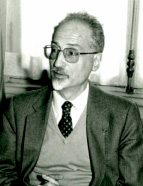

Born into a family of printers and publishers (Aigle, “L’oeuvre de Jean Aubin (1927-1998) et l’histoire globale”, 2018:11), Jean Aubin was born in 1927 in the town of Ligugé – Nouvelle Aquitaine, in central France. After studying languages such as Dutch, Hungarian and Swedish during his adolescence, he graduated from the École Nationale des Langues Orientales in Paris (1945-1948) where he learned Turkish, Arabic and Persian, eventually specialising in Iranian history and culture.
A scholarship holder at the University of Tehran in 1948-1949, Aubin joined the Institut franco-iranien d’Iranologie (1950-1955) the following year as an associate researcher. During this first long stay in Iran, the young historian focused his research on the country’s medieval history and the Turkish-Mongol invasions, consulting a large number of chronicles and archives. He also examined the position of medieval Iran as a civilisation situated “at the crossroads of the Mediterranean world, Asia and the Indian world” (Jean Aubin, “Liminaire”, in: Le Monde iranien et l’Islam , 1971: p. VIII). Between the late 1940s and the early 1950s, Aubin thus laid the theoretical foundations for a historiographical method “based both on a broad geopolitical vision and on the critical study of sources” (Geneviève Bouchon, “Introduction”, in: Le Latin et l’Astrolabe , 2000: p.10). Ultimately, before becoming one of the leading international researchers on the Portuguese empire in India, Aubin established himself as a pioneer of historical studies on medieval Iran in France.
Particularly concerned with examining and publishing unpublished primary sources related to the period of Aq Qoyunlu rule or the expansion of the Safavid empire, Jean Aubin published, in his first two decades of research, reference works such as Note sur quelques documents Aq Qoyunlu (1956), Note préliminaire sur les archives du Takya du Tchîma-rûd (1955), and Matériaux pour la biographie de Shâh Niʿmatullah Walí Kermânî (1956). Gradually broadening the scope of his research to encompass the entire Persian Gulf and Indian Ocean region in the late Middle Ages, Aubin also studied the formation of a diaspora of Iranian merchants and diplomats in the region. In this way, in addition to being the leading researcher in Persian studies in France, Aubin became, as historian Denise Aigle points out, one of the French representatives of “connected history” (Aigle, “L’oeuvre de Jean Aubin (1927-1998) et l’histoire globale,” 2018:13). It was this characteristic that gradually led him to take an interest in the Portuguese presence in India.
This work is financed by national funds through FCT - Foundation for Science and Technology, I.P, in the scope of the projects UIDB/04311/2020 and UIDP/04311/2020.
